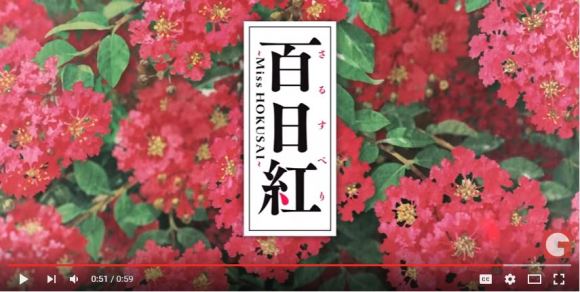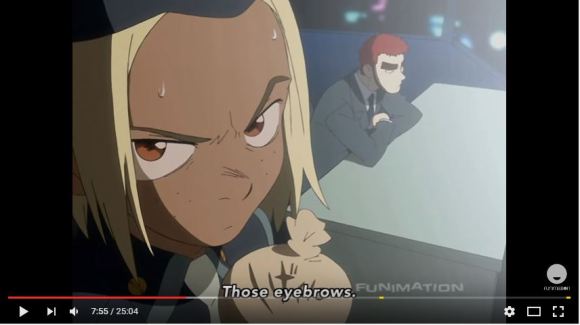
The little known daughter of ukiyo-e legend Hokusai is the main character in this animated featured film.
Even among non-Japanese painting enthusiasts, many people around the world recognize the name of the great Edo-period artist and printmaker Katsushika Hokusai (葛飾北斎), also known simply as Hokusai (1760-1849). He is, after all, the creator of the Thirty-six Views of Mt. Fuji woodblock print series, which includes the singularly famous The Great Wave off Kanagawa. However, what many people are unaware of is the existence of his daughter Katsushika Oi (葛飾応為) and her role in his burgeoning fame, as well as her own skills as an artist.
In fact, Oi is such a mysterious figure that even her exact dates of birth and death are unknown. Testimonials from her contemporaries cite her eccentric personality and her divorce from a man due to his poor art skills; her own father claimed that she drew portraits of beautiful women even more skillfully than him. Modern manga artist Hinako Sugiura sought to explore Oi’s enigmatic life in her father’s shadow in her Miss Hokusai (Japanese title: Sarusuberi/百日紅) historical manga series, which was originally serialized from 1983-87 in Weekly Manga Sunday magazine. This story was then adapted into a May 2015 anime film titled Miss Hokusai and directed by Keiichi Hara.
In this adaptation, Oi is portrayed as a 23-year-old woman who often paints in her father’s stead but remains uncredited. The film has already garnered a number of domestic and international awards since its release, with more likely to come following its greater international distribution. Check out the original trailer below:
GKids recently licensed the film for North America, with initial screenings in New York City and Los Angeles on October 14 to be followed by more widespread releases thereafter.
While I personally have yet to see Miss Hokusai, my excitement has been escalating both as a resident of North America and after reading that the film was produced by Production I.G of Ghost in the Shell fame. The art in the trailer also looks like a pleasant departure from the styles found in many contemporary Japanese animated feature films (not that I don’t love me some Studio Ghibli or Mamoru Hosoda works).
However, I am left with a single remaining comment after watching the trailer, which I’ll leave here for those of you so inclined:
Sources: Japaaan, Wikipedia
Images: YouTube/Cinema Today, YouTube/FUNimation


 Converse All-Stars team up with two all-stars of Japanese art for Wave, Skull ukiyo-e shoes【Pics】
Converse All-Stars team up with two all-stars of Japanese art for Wave, Skull ukiyo-e shoes【Pics】 Emperors, anime icons, and porn stars show up in six-nation survey of most famous Japanese people
Emperors, anime icons, and porn stars show up in six-nation survey of most famous Japanese people Erotic Japanese woodblock print underwear makes a statement when you take off your pants【Pics】
Erotic Japanese woodblock print underwear makes a statement when you take off your pants【Pics】 Japanese manhole covers become a hit with foreign tourists in off-the-beaten path Tokyo area
Japanese manhole covers become a hit with foreign tourists in off-the-beaten path Tokyo area Felissimo releases limited-edition “Color in Edo! Hokusai Colored Pencils” set
Felissimo releases limited-edition “Color in Edo! Hokusai Colored Pencils” set All-you-can-drink Starbucks and amazing views part of Tokyo’s new 170 meter-high sky lounge
All-you-can-drink Starbucks and amazing views part of Tokyo’s new 170 meter-high sky lounge McDonald’s new Happy Meals offer up cute and practical Sanrio lifestyle goods
McDonald’s new Happy Meals offer up cute and practical Sanrio lifestyle goods Mister Donut ready to make hojicha dreams come true in latest collab with Kyoto tea merchant
Mister Donut ready to make hojicha dreams come true in latest collab with Kyoto tea merchant Studio Ghibli glasses cases let anime characters keep an eye on your spectacles
Studio Ghibli glasses cases let anime characters keep an eye on your spectacles The oldest tunnel in Japan is believed to be haunted, and strange things happen when we go there
The oldest tunnel in Japan is believed to be haunted, and strange things happen when we go there Randomly running into a great sushi lunch like this is one of the best things about eating in Tokyo
Randomly running into a great sushi lunch like this is one of the best things about eating in Tokyo Starbucks reopens at Shibuya Scramble Crossing with new look and design concept
Starbucks reopens at Shibuya Scramble Crossing with new look and design concept Beautiful Sailor Moon manhole cover coasters being given out for free by Tokyo tourist center
Beautiful Sailor Moon manhole cover coasters being given out for free by Tokyo tourist center More foreign tourists than ever before in history visited Japan last month
More foreign tourists than ever before in history visited Japan last month Hamster abandoned at Tokyo ramen restaurant gets new home
Hamster abandoned at Tokyo ramen restaurant gets new home Disney princesses get official manga makeovers for Manga Princess Cafe opening in Tokyo
Disney princesses get official manga makeovers for Manga Princess Cafe opening in Tokyo Beautiful new Final Fantasy T-shirt collection on the way from Uniqlo【Photos】
Beautiful new Final Fantasy T-shirt collection on the way from Uniqlo【Photos】 Is the new Shinkansen Train Desk ticket worth it?
Is the new Shinkansen Train Desk ticket worth it? Foreign English teachers in Japan pick their favorite Japanese-language phrases【Survey】
Foreign English teachers in Japan pick their favorite Japanese-language phrases【Survey】 Japanese convenience store packs a whole bento into an onigiri rice ball
Japanese convenience store packs a whole bento into an onigiri rice ball We try out “Chan Ramen”, an underground type of ramen popular in the ramen community
We try out “Chan Ramen”, an underground type of ramen popular in the ramen community Studio Ghibli releases Kiki’s Delivery Service chocolate cake pouches in Japan
Studio Ghibli releases Kiki’s Delivery Service chocolate cake pouches in Japan Japan’s bone-breaking and record-breaking roller coaster is permanently shutting down
Japan’s bone-breaking and record-breaking roller coaster is permanently shutting down New definition of “Japanese whiskey” goes into effect to prevent fakes from fooling overseas buyers
New definition of “Japanese whiskey” goes into effect to prevent fakes from fooling overseas buyers Our Japanese reporter visits Costco in the U.S., finds super American and very Japanese things
Our Japanese reporter visits Costco in the U.S., finds super American and very Japanese things Studio Ghibli unveils Mother’s Day gift set that captures the love in My Neighbour Totoro
Studio Ghibli unveils Mother’s Day gift set that captures the love in My Neighbour Totoro Foreign passenger shoves conductor on one of the last full runs for Japan’s Thunderbird train
Foreign passenger shoves conductor on one of the last full runs for Japan’s Thunderbird train Domino’s Japan now sells…pizza ears?
Domino’s Japan now sells…pizza ears? New Japanese KitKat flavour stars Sanrio characters, including Hello Kitty
New Japanese KitKat flavour stars Sanrio characters, including Hello Kitty Kyoto creates new for-tourist buses to address overtourism with higher prices, faster rides
Kyoto creates new for-tourist buses to address overtourism with higher prices, faster rides Sales of Japan’s most convenient train ticket/shopping payment cards suspended indefinitely
Sales of Japan’s most convenient train ticket/shopping payment cards suspended indefinitely Sold-out Studio Ghibli desktop humidifiers are back so Totoro can help you through the dry season
Sold-out Studio Ghibli desktop humidifiers are back so Totoro can help you through the dry season Japanese government to make first change to romanization spelling rules since the 1950s
Japanese government to make first change to romanization spelling rules since the 1950s Ghibli founders Toshio Suzuki and Hayao Miyazaki contribute to Japanese whisky Totoro label design
Ghibli founders Toshio Suzuki and Hayao Miyazaki contribute to Japanese whisky Totoro label design Doraemon found buried at sea as scene from 1993 anime becomes real life【Photos】
Doraemon found buried at sea as scene from 1993 anime becomes real life【Photos】 Tokyo’s most famous Starbucks is closed
Tokyo’s most famous Starbucks is closed One Piece characters’ nationalities revealed, but fans have mixed opinions
One Piece characters’ nationalities revealed, but fans have mixed opinions We asked a Uniqlo employee what four things we should buy and their suggestions didn’t disappoint
We asked a Uniqlo employee what four things we should buy and their suggestions didn’t disappoint Princesses, fruits, and blacksmiths: Study reveals the 30 most unusual family names in Japan
Princesses, fruits, and blacksmiths: Study reveals the 30 most unusual family names in Japan Beautiful ukiyo-e woodblock print artwork appears on three of Japan’s premium beer brands
Beautiful ukiyo-e woodblock print artwork appears on three of Japan’s premium beer brands New live action Japanese comedy will star Jesus Christ and Buddha hanging out together
New live action Japanese comedy will star Jesus Christ and Buddha hanging out together Ghibli’s new Princess Kaguya trailer previews English dub
Ghibli’s new Princess Kaguya trailer previews English dub Mt Fuji and Raijin and Fujin lingerie sets let you wear your love for Japan under your clothes
Mt Fuji and Raijin and Fujin lingerie sets let you wear your love for Japan under your clothes Tokyo’s beautiful new license plates are based on one of Japan’s most famous woodblock paintings
Tokyo’s beautiful new license plates are based on one of Japan’s most famous woodblock paintings Snacks turned into art — these impressive visual creations are all made from food!
Snacks turned into art — these impressive visual creations are all made from food! Traditional artisans come together to create ukiyo-e enhanced Rolling Stones merchandise
Traditional artisans come together to create ukiyo-e enhanced Rolling Stones merchandise The Wind Rises U.S. TV spots streamed
The Wind Rises U.S. TV spots streamed Japanese pool player gives hilarious English interview complete with PPAP reference【Video】
Japanese pool player gives hilarious English interview complete with PPAP reference【Video】 Artist recreates famous Japanese ukiyo-e paintings using fine wines
Artist recreates famous Japanese ukiyo-e paintings using fine wines Amazing photos show Mt. Fuji looking just like an ukiyo-e woodblock painting
Amazing photos show Mt. Fuji looking just like an ukiyo-e woodblock painting Hayao Miyazaki Working on Proposed New Anime Feature Film
Hayao Miyazaki Working on Proposed New Anime Feature Film Enjoy traditional views of Mt Fuji from your very own luxury toilet
Enjoy traditional views of Mt Fuji from your very own luxury toilet Studio Ghibli’s The Boy and the Heron gets North American screening date in September
Studio Ghibli’s The Boy and the Heron gets North American screening date in September Shinkai’s “Your Name” tops South Korean box office with US$8.1 million
Shinkai’s “Your Name” tops South Korean box office with US$8.1 million
Leave a Reply